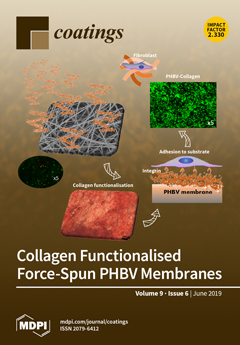In this paper, TiBCN-ceramic-reinforced Ti-based coating was fabricated on a Ti6Al4V substrate surface by laser cladding. The correlations between the main processing parameters and the geometrical characteristics of single clad tracks were predicted by linear regression analysis. On this basis, the microstructure, microhardness,
[...] Read more.
In this paper, TiBCN-ceramic-reinforced Ti-based coating was fabricated on a Ti6Al4V substrate surface by laser cladding. The correlations between the main processing parameters and the geometrical characteristics of single clad tracks were predicted by linear regression analysis. On this basis, the microstructure, microhardness, corrosion resistance, and wear resistance of the coating and the substrate were investigated. The results showed that the clad height, clad width, clad depth, and dilution rate depended mainly on the laser power, the powder feeding rate, and the scanning speed. TiBCN-ceramic-reinforced Ti-based coating was mainly composed of directional dendritic TiBCN phases, equiaxed TiN phases, needle-like Al
3Ti phases, and Ti phases. The microhardness gradually increased from the bottom to the top of the coating. The highest microhardness of coating was 1025 HV, which was three times higher than that of the Ti6Al4V substrate (350 HV). Furthermore, the coating exhibited excellent corrosion resistance and wear resistance. The corrosion potential (
Ecorr) reached −1.258 V, and the corrosion density (
Icorr) was 4.035 × 10
−5 A/cm
2, which was one order lower than that of the Ti6Al4V substrate (1.172 × 10
−4 A/cm
2). The coating wear mass loss was 4.35 mg, which was about two-third of the wear mass loss of the Ti6Al4V substrate (6.71 mg).
Full article





